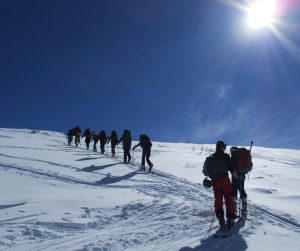The CRMS Osprey Story
Carbondale Magazine published a student-written article about the CRMS’s Biology class study of The Return of Osprey’s to the Roaring Fork Valley in their Winter/Spring 2021 issue. Below are an excerpt and a link to the entire article.
Imagine you are walking along the river, hopping from stone to stone, and you look up and see a massive 200‑pound nest that’s larger than you. This is the kind of nest Ospreys create after returning to the same nesting sites year after year. The nests start tiny, but with time, the Ospreys remodel with materials such as sticks and bark to make themselves a home for the rest of their lives. Unfortunately, this instinct can end very poorly for Ospreys if they end up nesting on top of power lines and other dangerous human‑made objects. This is what happened in October 2016 when Steve Hunter came to CRMS with concerns about an Osprey couple attempting to build a nest on an 80 foot‑tall XCEL power pole along highway 133 in Carbondale.
This spot made the Osprey’s nest especially susceptible to wind, which ended up blowing it off the pole and onto Highway 133 twice. In response to this problem, CRMS students took the initiative to create a suitable environment for the birds. With the problem identified, the students started to meticulously plan out what they had to do. First, they reached out to national and local experts, Alan Poole and Mary Harris, and Dee Malone, to learn about Osprey biology. After lots of research and discussion, the team of students decided to create one large pole with a nesting platform attached to it, as well as a camera for the community to watch the Osprey. This pole would be placed next to the Crystal River just below CRMS’s Tick Ridge. This would allow the birds to have easy access to fish from the river below. After deciding on this placement, the students reached out to XCEL Energy, Alpine Bank, and Pitkin County Healthy Rivers to help fund the project. XCEL agreed to supply the poles and hardware and install the platform for the Osprey. A group of students submitted grants to Alpine Bank and Pitkin County Healthy Rivers who then provided funding to purchase and install the Osprey Cam. After all of this work, the students were left with a huge platform for the Ospreys, a camera watching the platform, but no Ospreys. After waiting, day after day, the students saw nothing until two weeks and one day after the platform had been completed. Kayo Ogilby, the science teacher at CRMS saw a pair of Ospreys flying over the platform. He rushed inside and grabbed the students to show them that the Ospreys had found their home. Since that day, you can still observe the Osprey on the camera (between late March and September) if you visit the CRMS website.
Since then, the same breeding pair has come back every year for the past 4 years, and 12 chicks have been born. Even though three of them have died, CRMS’s efforts have really paid off. Now the town of Carbondale can view these amazing birds of prey right in their backyard, and CRMS students now have the chance to see and learn about Osprey up close.
 MYCRMS
MYCRMS





 Virtual Tour
Virtual Tour

